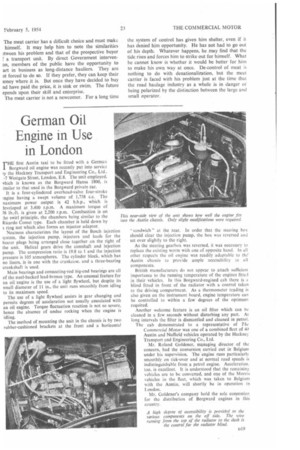German Oil Engine in Use in London
Page 59

If you've noticed an error in this article please click here to report it so we can fix it.
THE first Austin taxi to be fitted with a German Borgward oil engine was recently put into service )), the Hackney Transport and Engineering Co., Ltd.. -7 Westgate Street, London, E.8. The unit employed. vhich is known as the Borgward Hansa 1800, is ,imilar to that used in the Borgward private car.
It is a four-cylindcrcd overhead-valve four-stroke !ngine having a swept volume of 1,758 c.c. The naximum power output is 42 b.h.p., which is leveloped at 3,400 r.p.m. A maximum torque of
76 is given at 2,200 r.p.m. Combustion is on he swirl principle, the chambers being similar to the Ricardo Comet type. Each chamber is held down by I ring nut which, also forms an injector adaptor.
Neatness characterizes the layout of the Bosch injection system, the injection pump, injectors and leads for the heater plugs being arranged close together on the right of the unit. Helical gears drive the camshaft and injection pump. The compression ratio is 19.8 to I and the injection pressure is 105 atmospheres. The cylinder block, which has no liners, is in one with the crankcase, and a three-bearing crankshaft is used.
Main bearings and connecting-rod big-end bearings are all of the steel-backed lead-bronze type. An unusual feature for an oil 'engine is the use of a light flywheel, but despite its small diameter of II in., the unit runs smoothly from idling to its maximum speed.
The use of a light flywheel assists in gear changing and permits degrees of acceleration not usually associated with an oil engine. Torque fluctuation reaction is not so severe, hence the absence of undue rocking when the engine is idling. • The method of mounting the unit in the chassis is by two rubber-cushioned brackets at the front and a horizontal sandwich " at the rear. In order that the steering box should clear the injection pump, the box was reversed and set over slightly to the right.
As the steering gearbok was reversed, it was necessary to replace the existing worm with one of opposite hand. In all other respects the oil engine was readily adaptable to the Austin chassis to provide ample accessibility to all components.
British manufacturers do not appear to attach sufficient importance to the running temperature of the engines fitted in their vehicles. In this Borgward-engined cab there is a blind fitted in front of the radiator with a control taken to the driving compartment. As a thermometer reading is also given on the instrument board, engine temperature can be controlled to within a few degrees of the optimum required.
Another welcome feature is an oil filter which can be cleaned in a few seconds without disturbing any part. At long intervals the filter is dismantled and cleaned in petrol.
The cab demonstrated to a representative of The Commercial Motor was one of a combined fleet of 40 Austin and Nuffield vehicles operated by the Hackney Transport and Engineering co., Ltd.
Mr. Roland Goldencr, managing director of the concern, had the conversion carried out in Belgium under his supervision. The engine runs particularly smoothly on tick-over and at normal road speeds is indistinguishable from a petrol engine. Acceleration. too, is excellent. It is understood that the remaining vehicles are to be converted, and one of the Morris vehicles in the fleet, which was taken to Belgium with the Austin, will shortly be in operation in London.
Mr. Goldener's company hold the sole concession for the distribution of Borgward engines in this country.








































































































